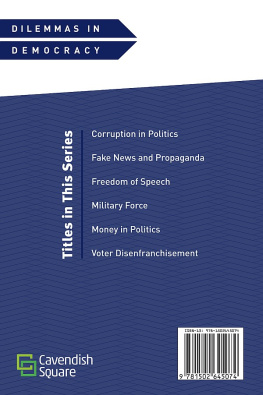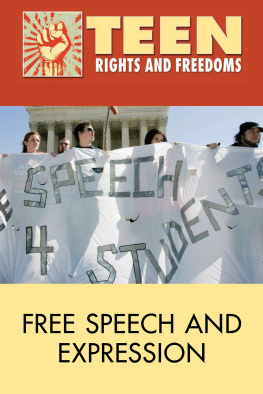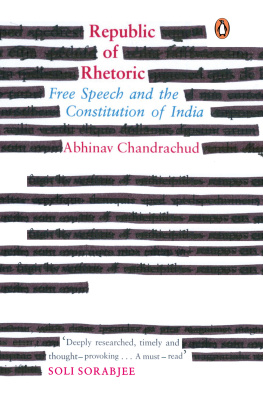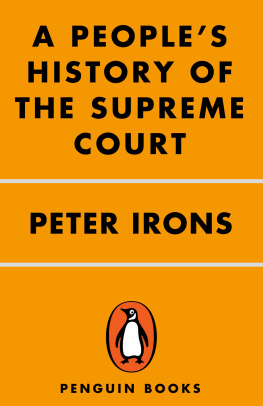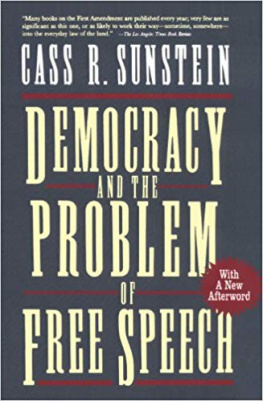Nat Hentoff - FIRST FREEDOM
Here you can read online Nat Hentoff - FIRST FREEDOM full text of the book (entire story) in english for free. Download pdf and epub, get meaning, cover and reviews about this ebook. year: 2012, publisher: Random House Childrens Books, genre: Politics. Description of the work, (preface) as well as reviews are available. Best literature library LitArk.com created for fans of good reading and offers a wide selection of genres:
Romance novel
Science fiction
Adventure
Detective
Science
History
Home and family
Prose
Art
Politics
Computer
Non-fiction
Religion
Business
Children
Humor
Choose a favorite category and find really read worthwhile books. Enjoy immersion in the world of imagination, feel the emotions of the characters or learn something new for yourself, make an fascinating discovery.

- Book:FIRST FREEDOM
- Author:
- Publisher:Random House Childrens Books
- Genre:
- Year:2012
- Rating:5 / 5
- Favourites:Add to favourites
- Your mark:
- 100
- 1
- 2
- 3
- 4
- 5
FIRST FREEDOM: summary, description and annotation
We offer to read an annotation, description, summary or preface (depends on what the author of the book "FIRST FREEDOM" wrote himself). If you haven't found the necessary information about the book — write in the comments, we will try to find it.
FIRST FREEDOM — read online for free the complete book (whole text) full work
Below is the text of the book, divided by pages. System saving the place of the last page read, allows you to conveniently read the book "FIRST FREEDOM" online for free, without having to search again every time where you left off. Put a bookmark, and you can go to the page where you finished reading at any time.
Font size:
Interval:
Bookmark:
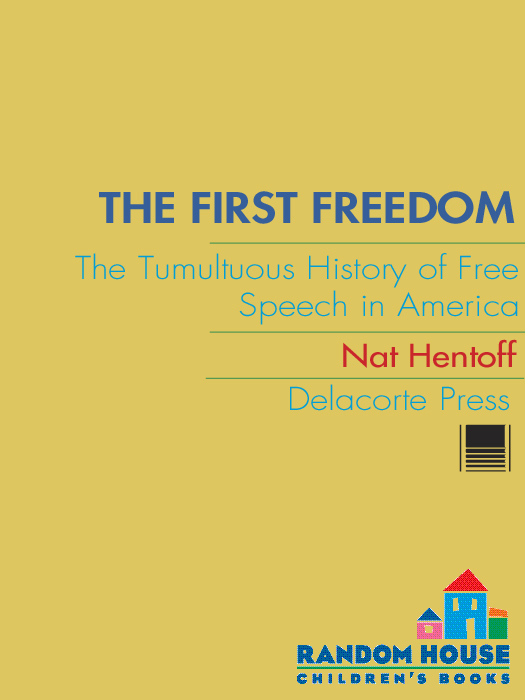
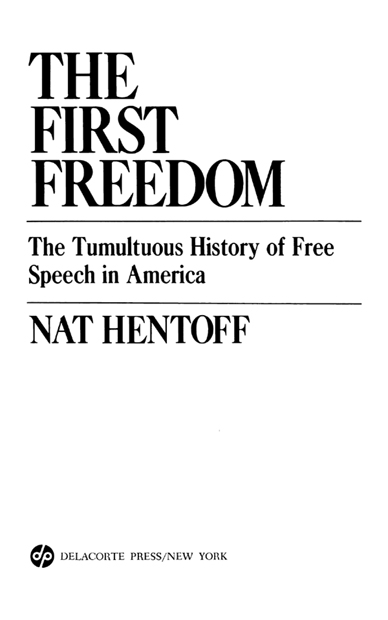
Published by
Delacorte Press
The Bantam Doubleday Dell Publishing Group, Inc.
1 Dag Hammarskjold Plaza
New York, New York 10017
Copyright 1980, 1981, 1988 by Namar Productions, Inc.
All rights reserved. No part of this book may be reproduced or transmitted in any form or by any means, electronic or mechanical, including photocopying, recording or by any information storage and retrieval system, without the written permission of the Publisher, except where permitted by law.
LIBRARY OF CONGRESS CATALOGING IN PUBLICATION DATA
Hentoff, Nat.
The first freedom : the tumultuous history of free speech in America / Nat Hentoff : with an afterword by the author.
p. cm.
Bibliography: p.
Summary: A history of free speech in our country from earliest times to some of the controversial court cases of today involving school demonstrations and the right of Nazis to march.
eISBN: 978-0-307-79990-6
1. Freedom of speechUnited StatesHistoryJuvenile literature. [1. Freedom of speechHistory.] I. Title.
KF4772.Z9H46 1988
342.730853dc19
[347.302853]
87-32182
v3.1
FOR WILLIAM O. DOUGLAS AND I. F. STONE
For my abiding concern with the First Amendment, I am particularly indebted to those officials at Northeastern University in Boston who tried to censor the writings of the staff when I was editor of the Northeastern News in the early 1940s. Most of us finally resigned in protest, and I never lost my sense of rage at those who would suppress speech, especially mine. Those administrators truly helped inspire this book.
I owe much to many who, through the years, have illuminated First Amendment history and law for me. Among them: Professor Thomas Emerson, who has set extraordinarily high standards for First Amendment scholarship, analysis, and passion both at Yale Law School and far, far beyond.
Being on the board of directors of the New York Civil Liberties Union has been an invaluable aid to my continuing education in civil libertiesdue to such rigorous instructors as Aryeh Neier, Ira Glasser, Burt Neuborne, Alan Levine, Kenneth Norwick, and Paul Chevigny. I have also learned a great deal from First Amendment lawyer-paladins Floyd Abrams and Victor Kovner, as well as from Sidney Zion, a journalist-lawyer whom James Madison would have welcomed as a hearty ally in pressing for the strongest possible Bill of Rights.
My appreciation too to the Student Press Law Center in Washington, and especially to those students throughout the country who have contacted me while engaged in their battles to keep the First Amendment exuberantly alive. My best hope for this book is that it will help forward many such battles, among students and all other citizens under the Constitution.
N AT H ENTOFF
C ongress shall make no law respecting an establishment of religion, or prohibiting the free exercise thereof, or abridging the freedom of speech, or of the press; or the right of the people peaceably to assemble, and to petition the Government for a redress of grievances.

Students/Teachers/Librarians: Free-speaking Persons under the Constitution
From Imagining the Death of the King to the Birth of the First Amendment
The Hard, Early Times of the First Amendment: From the Alien and Sedition Acts of 1798 to the Red Scare of the First World War
The Supreme Court of the United States Confronts Criminal Seditious Speech
Freedom ofand fromReligion under the First Amendment
The Constitutional Powers of the Free Press
The Outer Limits of Protected Speechand Beyond
I begin this account of the foundation of all our liberties with the young, for if they do not have reason to believe that the First Amendment is of real, palpable, personal value to them, its future will be in some peril.
It can hardly be argued that either students or teachers shed their constitutional rights to freedom of expression at the schoolhouse gate.
On the morning of December 16, 1965, thirteen-year-old Mary Beth Tinker arrived at her junior high school in Des Moines, Iowa. She was wearing a black armband. So was a friend, sixteen-year-old Christopher Eckhardt. And so too, the very next day, was Mary Beths fifteen-year-old brother, John.
They and their parents had planned what one of the students called a silent witness of the armbands from December 16 to January 1. The parents at their jobs and the teen-agers at school wanted to express their deep opposition to the war in Vietnam. Instead of giving antiwar speeches, or marching, they were engaging in symbolic speech. By wearing the black armbands they were both mourning the killings in Vietnam and also urging that they stop.
The principals of the Des Moines public schools had somehow learned of the silent protest, and two days before Mary Beth Tinker and Christopher Eckhardt appeared at school with their armbands the principals had met to decide how to deal with these nonviolent witnesses against war. It was agreed that any student wearing an armband would be told to remove it. If the student refused, he or she would be suspended and could return to school only when the armband had been left at home permanently.
The principals believed they were being entirely reasonable in barring the black armbands. They saw through the small band of black cloth. Silent or not, this was going to be a demonstration; and as one of them said at their meeting, The schools are no place for demonstrations. Said another principal, If the students dont like the way our elected officials are handling things, they should deliver their message through the ballot box and not in the halls of our public schools. That is, let them hold their messages until they are old enough to vote.
On December 16, Mary Beth Tinker and Christopher Eckhardt refused to remove their armbands. They were suspended. John Tinker went through the same process the next morning. The three did not return to school until after New Years Day, when by their own previous decision the period of protesting by armbands was over.
Although the school principals considered the incident closed, the three students brought suit in federal court to establish their First Amendment right to wear the black armbands. At first, the students lost. The Federal District Court ruled that since this kind of symbolic expression might disturb school discipline, school officials could reasonably and constitutionally compel the students to leave the armbands at home. The next higher court, the United States Court of Appeals for the Eighth Circuit, was divided equally (44); and so the lower courts decision stood.
There was only one more place to go. On February 24, 1969, to the joy of the Tinkers and Christopher Eckhardt, the United States Supreme Court, by a vote of 7 to 2, decided in their favor. The decision,
Font size:
Interval:
Bookmark:
Similar books «FIRST FREEDOM»
Look at similar books to FIRST FREEDOM. We have selected literature similar in name and meaning in the hope of providing readers with more options to find new, interesting, not yet read works.
Discussion, reviews of the book FIRST FREEDOM and just readers' own opinions. Leave your comments, write what you think about the work, its meaning or the main characters. Specify what exactly you liked and what you didn't like, and why you think so.

